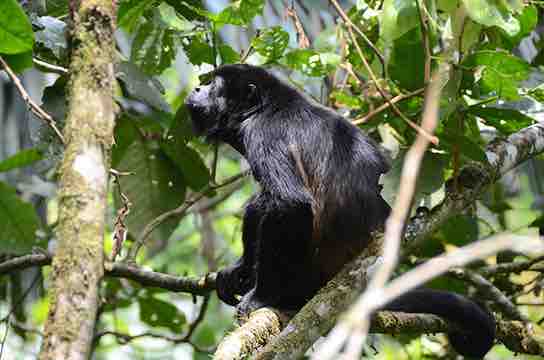Characteristics of Primates
All primate species possess adaptations for climbing trees, as they all descended from tree-dwellers. This arboreal heritage of primates has resulted in adaptations that include, but are not limited to: 1) a rotating shoulder joint; 2) a big toe that is widely separated from the other toes and thumbs, that are widely separated from fingers (except humans), which allow for gripping branches; and 3) stereoscopic vision, two overlapping fields of vision from the eyes, which allows for the perception of depth and gauging distance. Other characteristics of primates are brains that are larger than those of most other mammals (larger brain/body ratio than similar-sized non-primates), claws that have been modified into flattened nails, typically only one offspring per pregnancy, and a trend toward holding the body upright.
The Order Primates is divided into two groups: prosimians and anthropoids. Prosimians include the bush babies and pottos of Africa, the lemurs of Madagascar, and the lorises of Southeast Asia. Tarsier, also from Southeast Asia, show some prosimian-like and some anthropoid-like features. Anthropoids include monkeys, apes, and humans. In general, prosimians tend to be nocturnal (in contrast to diurnal anthropoids, excluding the nocturnal Aotus, owl monkey) and have a smaller brain/body ratio than anthropoids.
Evolution of Primates
The first primate-like mammals are referred to as proto-primates. They were roughly similar to squirrels and tree shrews in size and appearance. The existing fossil evidence (mostly from North Africa) is very fragmentary. These proto-primates will remain largely mysterious creatures until more fossil evidence becomes available. The oldest known primate-like mammal with a relatively robust fossil record is Plesiadapis (although some researchers do not agree that Plesiadapis was a proto-primate). Fossils of this primate have been dated to approximately 55 million years ago. Plesiadapiforms had some features of the teeth and skeleton in common with true primates. They were found in North America and Europe in the Cenozoic, going extinct by the end of the Eocene.
The first true primates were found in North America, Europe, Asia, and Africa in the Eocene Epoch. These early primates resembled present-day prosimians such as lemurs. Evolutionary changes continued in these early primates, with larger brains and eyes, and smaller muzzles being the trend. By the end of the Eocene Epoch, many of the early prosimian species went extinct due either to cooler temperatures or competition from the first monkeys.
Evidence shows that the anthropoid monkeys evolved from prosimians during the Oligocene Epoch. By 35 million years ago, evidence indicates that monkeys were present the Old World (Africa and Asia) and in the New World (South America) by 30 million years ago. New World monkeys are also called Platyrrhini: a reference to their broad noses . Old World monkeys (and apes) are called Catarrhini: a reference to their narrow noses. There is still quite a bit of uncertainty about the origins of the New World monkeys. At the time the platyrrhines arose, the continents of South American and Africa had drifted apart. Therefore, it is thought that monkeys arose in the Old World and reached the New World by drifting on log rafts or mangrove floating 'islands'. Due to this reproductive isolation, New World monkeys and Old World monkeys underwent separate adaptive radiations over millions of years. The New World monkeys are all arboreal, whereas Old World monkeys include arboreal and ground-dwelling species.

Howler monkey
The howler monkey, a member of the Platyrrhini, is native to Central and South America. It makes a call that sounds like a lion roaring.
Apes evolved from the catarrhines in Africa midway through the Cenozoic during the Miocene epoch, approximately 25 million years ago. Apes are generally larger than monkeys and do not possess a tail. All apes are capable of moving through trees, although many species spend most their time on the ground. Apes are more intelligent than monkeys as they have relatively larger brains proportionate to body size.
The apes are divided into two groups. The lesser apes comprise the family Hylobatidae, including gibbons and siamangs. The great apes include the genera Pan (chimpanzees and bonobos), Gorilla (gorillas), Pongo (orangutans), and Homo (humans) . The very arboreal gibbons are smaller than the great apes; they have low sexual dimorphism (that is, the genders are not markedly different in size); and they have relatively longer arms used for swinging/brachiating through trees.

Chimpanzee
The (a) chimpanzee is one of the great apes. It possesses a relatively large brain and has no tail. (b) All great apes have a similar skeletal structure.